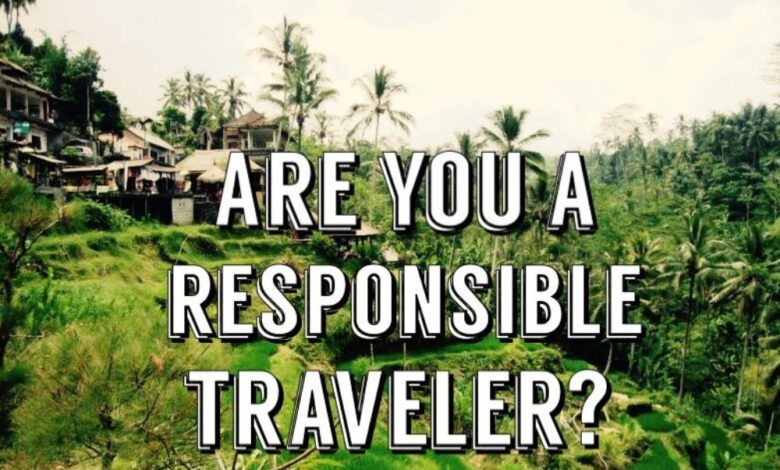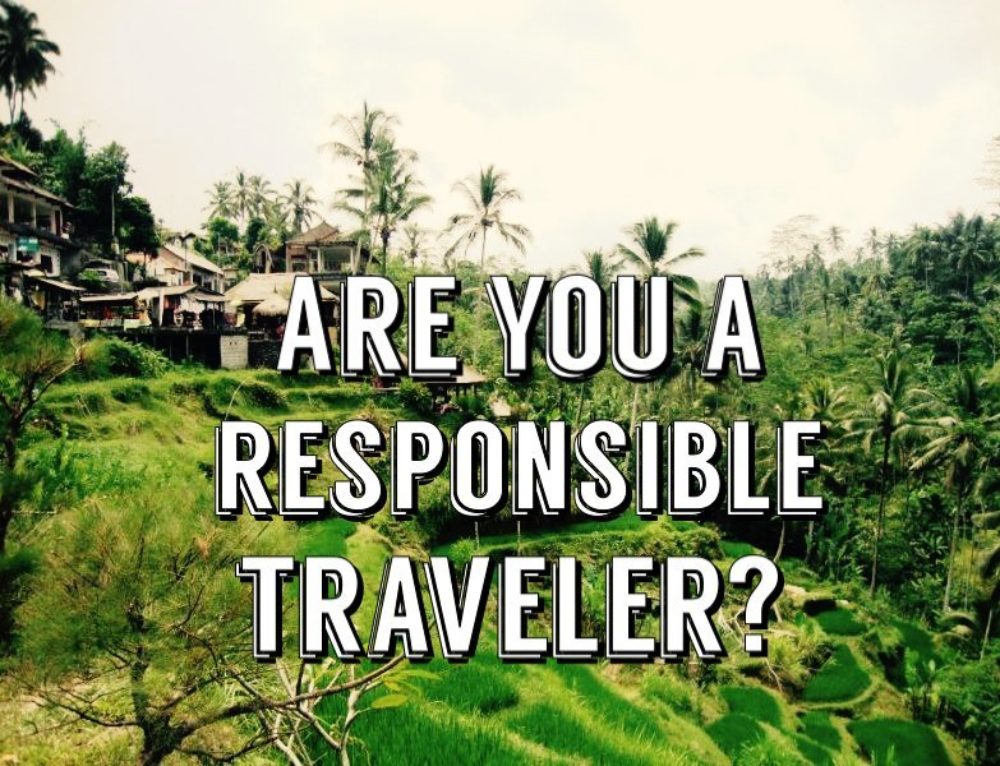
Are We Responsible Enough to Travel Yet?
Are we responsible enough to travel yet? This question explores the multifaceted considerations surrounding travel in our current global context. From evaluating environmental and social impacts to understanding evolving health protocols and accessibility issues, the decision to travel requires careful thought and planning. This journey delves into the complexities of responsible travel, empowering readers to make informed choices about their next adventure.
We’ll examine the ethical dimensions of tourism, exploring the interplay between personal values, economic impacts, and global health concerns. This exploration aims to provide a comprehensive framework for assessing personal readiness and choosing sustainable travel options.
Defining “Responsible Travel”
Responsible travel goes beyond the simple act of sightseeing. It’s a conscious choice to minimize negative impacts on the environment, local communities, and cultures while maximizing positive experiences for all involved. It’s about understanding the interconnectedness of our actions and destinations, and striving to leave a positive footprint. It’s a mindset that values respect, sustainability, and ethical engagement.Responsible travel seeks to balance the desires of tourists with the needs and well-being of host communities and the environment.
This means prioritizing local businesses, supporting fair labor practices, and respecting cultural norms and traditions. Ultimately, responsible travel aims to create a more sustainable and equitable tourism industry.
Defining Responsible Travel Practices
Responsible travel encompasses a multifaceted approach that considers environmental, social, and cultural impacts. It’s not a one-size-fits-all solution, but a continuous process of learning and adaptation.
- Environmental Responsibility involves minimizing ecological harm. This includes reducing carbon emissions through eco-friendly transportation, conserving water and energy, and supporting sustainable accommodations and activities. For example, opting for walking tours instead of motorized transport, or staying in eco-lodges that prioritize renewable energy, can greatly contribute.
- Social Responsibility centers on fair labor practices and community empowerment. Supporting locally owned businesses, engaging with local communities in a respectful manner, and ensuring fair wages for workers are key aspects. This means choosing accommodations and tour operators committed to fair trade and ethical employment practices.
- Cultural Responsibility necessitates respect for local traditions, customs, and beliefs. Learning about the history and culture of the destination, respecting dress codes, and avoiding behaviors that might be considered offensive are essential. Respecting local traditions, understanding customs, and avoiding stereotypes is crucial for a positive interaction.
Differentiating Responsible Travel from Tourism
While tourism often focuses on leisure and recreation, responsible travel adds a crucial layer of ethical consideration. Tourism, in its broadest sense, is the act of travelling for leisure or other purposes. Responsible travel adds a layer of conscious action to minimize negative impact and maximize positive effects.
Honestly, are we responsible enough to travel yet? With the world still navigating the complexities of recent events, it feels like a delicate balance. However, seeing the ample diversions on Louis Cristal Aegean sailing, like exploring hidden coves and indulging in local delicacies , rekindles a sense of adventure. Perhaps, with thoughtful planning and a conscious approach, responsible travel is indeed possible.
- Tourism is often driven by profit maximization, with less emphasis on environmental and social impacts. Responsible travel prioritizes minimizing negative consequences and maximizing benefits for all stakeholders.
- Tourism can sometimes lead to exploitation of local resources and communities. Responsible travel aims to ensure that local communities benefit from tourism, and that resources are managed sustainably.
Evaluating the Responsibility of Travel Plans
A framework for evaluating the responsibility of travel plans can be structured around these key components:
- Environmental Impact Assessment: Evaluate the carbon footprint of transportation, accommodation choices, and activities. Consider the use of sustainable transportation, energy-efficient accommodations, and low-impact activities.
- Social Impact Assessment: Analyze the potential for supporting local businesses, fair wages, and community development. Assess the impact on local employment and livelihoods.
- Cultural Sensitivity Assessment: Evaluate the potential for cultural understanding and respect. Consider the potential for cultural misunderstandings or disrespect, and ways to avoid them.
Comparing Approaches to Responsible Travel
Different approaches to responsible travel exist, each with its own emphasis.
| Approach | Focus | Examples |
|---|---|---|
| Eco-tourism | Minimizing environmental impact, supporting conservation efforts, and educating tourists about local ecosystems. | Participating in guided nature walks, staying in eco-lodges, supporting local conservation projects. |
| Ethical Tourism | Prioritizing fair labor practices, supporting local communities, and promoting human rights. | Choosing accommodations and tour operators that adhere to fair trade principles, supporting local artisans and farmers, engaging in community-based tourism projects. |
Global Health and Safety Considerations

The world is still navigating the ongoing impact of the pandemic on travel. While restrictions have eased significantly in many areas, the global health landscape remains dynamic. Understanding the current situation, evolving protocols, and regional differences is crucial for responsible travelers. This section will explore the critical health considerations impacting travel decisions today.The pandemic has highlighted the interconnectedness of global health.
Changes in disease transmission, new variants, and the varying efficacy of vaccines across regions necessitate a cautious and informed approach to international travel. Travelers must be prepared to adapt to shifting circumstances and remain vigilant about their own health and the health of those around them.
Current Global Health Situation and its Impact on Travel Decisions
The COVID-19 pandemic continues to influence travel decisions, although the intensity of restrictions has lessened. Countries with high vaccination rates and low infection rates tend to have fewer travel restrictions. However, the emergence of new variants and local outbreaks can lead to sudden changes in travel advisories and quarantine requirements. Travelers need to remain flexible and closely monitor travel advisories for destinations they are considering.
Countries might also impose mandatory testing or quarantine requirements for travelers, especially those coming from areas with high infection rates.
Evolving Health Protocols and Guidelines for International Travel
Health protocols for international travel are continuously evolving. Countries are implementing various measures, including mandatory vaccination requirements, pre-departure testing, and the use of health passports. These protocols can vary significantly between destinations, making it essential for travelers to research and understand the specific requirements for their chosen travel route. This requires diligent research and ongoing monitoring of the specific guidelines.
Examples of How Different Countries are Addressing the Pandemic’s Impact on Travel
Different countries have adopted various strategies to manage the pandemic’s impact on travel. Some countries, like Singapore, have implemented robust testing and contact tracing systems, which have facilitated a relatively smooth return to international travel. Others have relied on vaccination mandates or travel restrictions targeted at specific countries or regions. These varied approaches demonstrate the complexity and dynamism of the situation.
Comparison of Health Safety Protocols of Different Destinations
Health safety protocols vary considerably between destinations. Countries with robust public health infrastructure may have more lenient travel requirements than those with limited resources. For example, countries with high vaccination rates might have fewer restrictions for vaccinated travelers compared to those with lower vaccination rates. Thorough research into the specific health guidelines of the destinations will be required for a safe and smooth travel experience.
Potential Health Risks and Precautions for Travelers in Various Regions
| Region | Potential Health Risks | Precautions |
|---|---|---|
| Southeast Asia | Dengue fever, Zika virus, and other vector-borne illnesses | Consult a doctor about appropriate vaccinations and preventive measures. Use insect repellent and cover exposed skin. |
| Sub-Saharan Africa | Malaria, yellow fever, and other infectious diseases | Consult a doctor about appropriate vaccinations and preventive measures. Take necessary precautions against mosquito bites. |
| South America | Zika virus, Dengue fever, Chikungunya | Consult a doctor about appropriate vaccinations and preventive measures. Use insect repellent and cover exposed skin. |
| North America | Seasonal illnesses, local outbreaks | Maintain good hygiene practices. Consult a doctor about necessary vaccinations and preventive measures. |
Infrastructure and Accessibility

Beyond the immediate concerns of health and safety, responsible travel hinges on the robust infrastructure that supports our journeys. Reliable transportation, accessible destinations, and well-maintained facilities all contribute to a positive and safe experience. This aspect goes beyond mere convenience; it directly impacts the inclusivity and sustainability of travel for everyone. Understanding the infrastructure’s fragility and potential vulnerabilities is crucial for responsible travel choices.The accessibility of travel experiences is not simply about physical barriers, but also about ensuring that diverse groups of travelers can fully participate and enjoy their journeys.
This encompasses not just physical limitations, but also cultural and language differences, and varying levels of mobility and independence. A robust and adaptable infrastructure is critical to fostering a welcoming and equitable travel environment.
Honestly, are we responsible enough to travel yet? It’s a complex question, especially considering the current state of affairs. Examining the political landscape surrounding transportation, like Amtrak at the junction of travel and politics, amtrak at junction of travel and politics , reveals a lot about the pressures and challenges involved. Ultimately, responsible travel requires careful consideration of both individual and collective impact, making the question even more profound.
Critical Travel Infrastructure Elements
The reliability of transportation networks, from airports and train stations to roads and bridges, plays a significant role in the overall safety and efficiency of travel. This includes factors like the availability of well-maintained infrastructure, adequate staffing, clear signage, and efficient communication systems. The consistency and quality of these elements are paramount for both ease of travel and safety.
Delays, disruptions, and poorly maintained facilities can severely impact a traveler’s experience and safety.
Accessibility Considerations for Diverse Travelers
Accessibility considerations extend beyond physical limitations to encompass a broader spectrum of needs. Travelers with mobility impairments, visual or hearing impairments, and cognitive differences all require specific accommodations to ensure a positive and inclusive experience. This includes provisions for accessible transportation options, communication aids, and appropriately designed facilities. Accommodation needs should be proactively considered and planned for, not as an afterthought.
Examples of this include wheelchair ramps, tactile paving, audio descriptions for visual aids, and readily available sign language interpreters.
Role of Technology in Enhancing Travel Safety and Accessibility
Technological advancements are revolutionizing travel, creating opportunities to enhance safety and accessibility for all. Real-time tracking systems, automated check-in procedures, and GPS-enabled navigation tools provide increased convenience and safety. Mobile apps can offer vital information, translation services, and emergency assistance. These advancements can bridge geographical and cultural divides, ensuring that everyone can experience the world more easily and safely.
Potential Impact of Climate Change on Travel Infrastructure
Climate change poses a significant threat to travel infrastructure, potentially leading to disruptions and hazards. Rising sea levels, extreme weather events, and natural disasters can damage or destroy crucial infrastructure components. The impact varies significantly across different regions and types of infrastructure. This necessitates proactive measures for adaptation and resilience in travel planning. For example, coastal areas face increased flooding risks, necessitating the construction of higher seawalls and the relocation of infrastructure.
Likewise, infrastructure in mountainous areas may be vulnerable to landslides or avalanches.
Accessibility Features and Requirements of Various Transportation Methods
| Transportation Method | Accessibility Features | Accessibility Requirements |
|---|---|---|
| Air Travel | Wheelchair accessible boarding, assistance from airport staff, accessible restrooms, audio descriptions | Pre-booking of assistance, notification of any potential disruptions |
| Rail Travel | Wheelchair accessible carriages, tactile paving, audio announcements | Advance planning for appropriate accommodations, specific needs communicated to the railway |
| Road Travel | Wheelchair accessible vehicles, designated parking spaces, ramps, clear signage | Advance reservations for accessible vehicles, clear communication of accessibility needs |
| Cruise Travel | Accessible cabins, assistance with mobility, ramps, accessible restrooms | Detailed information on accessibility features, clear communication of any limitations |
Economic and Social Impacts of Travel
Travel, in its various forms, has profound and multifaceted effects on local communities. Beyond the immediate experiences of tourists and travelers, the economic and social ramifications ripple through host societies, presenting both opportunities and challenges. Understanding these impacts is crucial for responsible travel, allowing us to navigate the complexities and strive for positive outcomes for all stakeholders.
Economic Consequences of Travel
The economic consequences of travel can be substantial and varied. Positive impacts include increased employment opportunities in the tourism sector, boosting local economies through spending by tourists. Small businesses, from restaurants to craft shops, benefit directly from the influx of customers. However, negative impacts can also occur. Unregulated tourism can lead to price increases for essential goods and services, potentially making them inaccessible to local residents.
The dependence on tourism can also make local economies vulnerable to external factors, such as economic downturns or natural disasters. Furthermore, the influx of tourists can strain local infrastructure, leading to increased costs for essential services.
Social Impacts of Travel
Travel can foster cultural exchange and understanding, leading to enriched social experiences for both tourists and locals. Exposure to diverse cultures can broaden perspectives and challenge preconceived notions. However, such interactions can also present challenges. Misunderstandings or clashes can arise due to differing cultural norms and expectations. Furthermore, tourism can contribute to the commodification of culture, potentially leading to the loss of authenticity or the exploitation of local traditions.
Ethical Considerations
Ethical considerations surrounding the economic and social impacts of tourism are paramount. Responsible travel requires a commitment to minimizing negative impacts and maximizing positive ones. This includes supporting local businesses, respecting local customs and traditions, and advocating for fair wages and working conditions for local employees. Furthermore, tourists should be mindful of their consumption habits and strive to reduce their environmental footprint.
Table: Economic Benefits and Challenges of Travel for Different Regions
| Region | Economic Benefits | Economic Challenges |
|---|---|---|
| Developing Countries (e.g., Southeast Asia) | Increased employment opportunities in hospitality and related sectors, foreign investment, infrastructure development. Example: The growth of the tourism sector in Thailand has led to the creation of thousands of jobs and the development of new hotels and resorts. | Potential for exploitation of local resources and labor, environmental degradation, cultural commodification. Example: The rise in tourism in some parts of Costa Rica has led to deforestation and habitat loss. |
| Developed Countries (e.g., Europe) | Tourism revenue generates significant income for local businesses and governments, contributes to regional economic growth, fosters local jobs. Example: The French Riviera’s tourism industry generates substantial revenue for the region and supports many businesses. | Strain on infrastructure, potential displacement of residents due to rising property prices, cultural homogenization. Example: Overtourism in Venice has caused congestion, pollution, and rising rents, making the city less affordable for locals. |
| Island Nations | Tourism often represents a crucial part of the economy, providing employment and income. Example: The Maldives’ economy heavily relies on tourism, and the revenue helps fund vital infrastructure and social services. | Fragility of island ecosystems to environmental damage, dependence on foreign investment potentially impacting local sovereignty, and the impact of climate change. Example: Rising sea levels and increased storm activity threaten the sustainability of island tourism destinations. |
Personal Responsibility in Travel Decisions
Traveling responsibly is more than just a trend; it’s a crucial element in ensuring a positive impact on the destinations we visit. Beyond the obvious environmental concerns, responsible travel encompasses a wider spectrum of considerations, acknowledging the intricate web of connections between our actions and the communities we encounter. This personal responsibility extends to every aspect of our travel planning and execution.Personal factors play a significant role in shaping our travel choices and the decisions we make.
Considering if we’re responsible enough to travel again feels tricky, right? It’s a question weighing on many of us. But witnessing the impressive achievements of the dozens of graduates honored at a transformational leadership ceremony, like those celebrated at this one , makes me think. Maybe, if we’re fostering future leaders capable of navigating complex challenges, we’re also building the responsible travelers of tomorrow.
So, maybe we are ready to explore the world once more.
From the practical to the philosophical, these elements intertwine to create the experience we have. Understanding these influences allows us to approach travel with a greater awareness of our impact and to make more informed, responsible choices.
Thinking about whether we’re ready to travel again? It’s a tricky question, isn’t it? With analysts predicting caution in credit card use, it seems like responsible spending might be top of mind for many. This analyst predicting caution in credit card use suggests a potential shift in how we approach travel budgets, which makes me wonder if we’re truly ready to embrace the freedom of travel without overextending ourselves financially.
Maybe we need to take a step back and reassess our travel priorities before we book that next adventure.
Personal Factors Influencing Travel Decisions
Personal preferences, needs, and circumstances often drive our travel choices. Budgetary constraints, time limitations, and individual values all contribute to the final destination selection. Travelers with limited budgets might opt for destinations with lower living costs, while those with ample time may choose extended stays in more culturally immersive environments. Values like adventure, relaxation, or cultural immersion significantly impact the types of experiences sought and the destinations selected.
With the world slowly reopening, the question of whether we’re responsible enough to travel again lingers. While the debate rages on, Adventuresmith has announced a fantastic Hawaii cruise offering, promising a safe and enjoyable getaway. But before we all book our trips, let’s consider if the desire for adventure outweighs the need for caution. Adventuresmith announces hawaii cruise offering raises the stakes on responsible travel, and ultimately, the answer to whether we’re ready to travel rests with each individual.
Importance of Individual Responsibility in Mitigating Negative Impacts
Individual actions, though seemingly small, collectively create a powerful impact. Our choices, from the transportation mode we select to the accommodation we choose, influence the environmental footprint and the social interactions we have. A conscious effort to minimize our negative impact, like choosing eco-friendly transportation or supporting local businesses, can make a substantial difference.
Role of Personal Research and Preparation in Responsible Travel
Thorough research and preparation are vital for responsible travel. Understanding local customs, respecting cultural norms, and learning basic phrases in the local language are crucial steps. Knowing the potential environmental concerns of a destination, the local infrastructure, and the cultural sensitivities of the area helps travelers to navigate the region respectfully and avoid unintentionally causing harm.
Personal Values Shaping Travel Choices
Personal values act as a compass, guiding our choices and shaping our interactions with different cultures and environments. For instance, a traveler valuing sustainability might prioritize eco-tourism destinations and opt for locally owned accommodations. Similarly, a traveler prioritizing cultural immersion might actively seek out opportunities to interact with local communities and learn about their traditions.
Checklist for Assessing Personal Readiness for Responsible Travel
- Financial Considerations: Have I considered my budget realistically, accounting for all potential expenses? Am I prepared for unexpected costs or changes in plans?
- Time Commitment: Have I assessed the time commitment required for my trip, including travel time, and potential delays?
- Personal Values: Have I identified my personal values regarding travel and how they align with my desired experiences? How will my personal values influence my interactions with the local community?
- Research & Preparation: Have I researched the destination’s environmental impact, cultural norms, and local customs? Have I familiarized myself with any specific safety guidelines or advisories?
- Ethical Considerations: Have I considered the potential social and economic impacts of my travel decisions on local communities? Am I prepared to support local businesses and communities?
- Environmental Impact: Have I considered my travel choices’ environmental impact, including carbon emissions and waste generation? Have I considered alternatives to minimize my footprint?
Travel Options and Alternatives
Embarking on a journey doesn’t have to come at the expense of our planet or local communities. Responsible travel extends beyond choosing accommodations and transportation; it encompasses a thoughtful consideration of the various options available and their impact. This section delves into sustainable travel alternatives, highlighting their benefits and drawbacks to help you make informed choices.Choosing responsible travel options is increasingly important in today’s world, as traditional tourism often carries negative environmental and social consequences.
The shift towards sustainable practices allows us to experience destinations while minimizing our footprint and supporting local economies.
Sustainable Travel Options
Sustainable travel options range from eco-lodges and community-based tourism to alternative transportation methods. These choices provide travelers with a more meaningful and impactful experience while minimizing their environmental and social impact. The key is to select options that respect the environment, support local communities, and contribute to a more equitable tourism landscape.
- Eco-lodges: These accommodations prioritize environmental sustainability through energy efficiency, waste reduction, and support for local conservation efforts. They often utilize renewable energy sources, employ locally sourced materials, and minimize their impact on the surrounding ecosystem. Examples include lodges built with natural materials, utilizing solar panels, and actively participating in reforestation projects. However, cost can be a barrier for some travelers, and the selection of eco-lodges may be limited in certain destinations.
- Community-based tourism: This model directly benefits local communities by providing employment opportunities, supporting local businesses, and empowering local residents. This form of tourism allows travelers to interact directly with the local culture, learn about traditional crafts, and participate in community activities. It fosters cultural exchange and provides economic benefits for the host community. Challenges may include logistical difficulties in coordinating experiences or potential cultural misunderstandings if not handled carefully.
- Alternative Transportation: Shifting away from private vehicles to sustainable transportation options like cycling, walking, or using public transport reduces carbon emissions and fosters a healthier travel experience. This can involve renting bicycles for exploring a city or region, or utilizing local public transportation systems. This approach also provides a unique way to interact with the local environment. However, accessibility and infrastructure limitations might be significant obstacles in some destinations.
Additionally, the availability of these options may vary depending on the destination.
Benefits and Drawbacks of Different Travel Options
Each sustainable travel option comes with its own set of advantages and disadvantages. A balanced evaluation is essential to making informed choices.
- Eco-lodges often provide luxurious accommodations with amenities, while maintaining their commitment to sustainability. However, their prices might be significantly higher compared to traditional hotels. The quality of the experience can also vary depending on the lodge’s management and adherence to eco-friendly principles.
- Community-based tourism fosters genuine cultural exchange and empowers local communities. However, it may require more research and planning to ensure that experiences are authentic and not exploitative.
- Alternative transportation reduces carbon footprints and offers unique perspectives. However, the availability and accessibility of alternative transportation options can differ significantly between locations.
Criteria for Selecting Responsible Travel Options
Several factors influence the selection of responsible travel options. Prioritizing environmental and social considerations is crucial.
- Environmental Impact: Assess the carbon footprint of transportation, accommodation, and activities. Consider the impact on local ecosystems and wildlife.
- Social Impact: Ensure that the chosen option supports local communities economically and respects their culture and traditions. Avoid activities that exploit local populations or their environment.
- Ethical Considerations: Evaluate the authenticity and transparency of the chosen option. Avoid experiences that promote unsustainable or exploitative practices.
Successful Sustainable Tourism Initiatives
Numerous examples showcase successful sustainable tourism initiatives. These demonstrate that responsible travel is not just a trend but a practical approach.
- Many national parks and conservation organizations are incorporating sustainable practices, including eco-lodges and community-based tourism initiatives, to manage visitor numbers and protect fragile environments.
- Examples like community-owned eco-lodges in Costa Rica and sustainable cycling tours in Vietnam highlight the positive impacts of community-based tourism.
Comparison Table of Sustainable Travel Options
| Travel Option | Environmental Impact | Local Community Impact | Example |
|---|---|---|---|
| Eco-lodge | Low to Moderate (depending on specific practices) | Positive (often supports local employment and conservation) | A lodge using solar power and employing local staff |
| Community-based tourism | Low to Moderate (depending on the specific activities) | High (directly benefits local communities) | A tour that features local artisans and crafts |
| Alternative Transportation | Low (significantly reduces carbon emissions) | Moderate (supports local businesses, such as bicycle rental shops) | Cycling through a national park |
Assessing Personal Readiness for Travel: Are We Responsible Enough To Travel Yet

Embarking on a journey requires careful consideration beyond simply packing your bags. True travel preparedness encompasses a holistic evaluation of your personal readiness, encompassing physical, mental, and logistical factors. This assessment goes beyond basic planning and delves into the nuances of responsible travel, ensuring a fulfilling and impactful experience.Understanding your own limitations and capabilities is crucial. A thorough self-assessment can identify potential challenges and allow you to proactively address them, ensuring a smoother and more enjoyable trip.
It also promotes awareness of the impact your travel choices have on the destinations you visit.
Self-Reflection and Awareness
Self-reflection is paramount in assessing your personal readiness for travel. Understanding your emotional state, physical limitations, and personal values is crucial for making informed decisions. This introspection helps anticipate potential challenges and tailor your travel plans accordingly. A traveler aware of their personal limitations is better equipped to navigate unforeseen circumstances. Consider your comfort level with unfamiliar environments, your tolerance for stress, and your ability to adapt to unexpected situations.
Understanding these factors allows for proactive planning and minimizes potential discomfort.
Step-by-Step Readiness Evaluation, Are we responsible enough to travel yet
A structured process aids in assessing your readiness. This involves a systematic evaluation of your physical, mental, and logistical preparedness. A step-by-step approach helps you approach travel with a balanced perspective.
- Physical Health: Assess your current health status. Consult with your doctor about any potential health concerns that might affect your travel plans, particularly for destinations with different health risks. Consider any medications you require and ensure you have sufficient supplies for your trip duration.
- Financial Stability: Evaluate your budget and allocate sufficient funds for the trip, including unforeseen expenses. Create a detailed budget that accounts for all potential costs, including flights, accommodation, activities, and food. Explore options for travel insurance and emergency funds.
- Passport and Visa Requirements: Verify the validity of your passport and necessary visas well in advance of your departure date. Review travel advisories and restrictions specific to your destination.
- Travel Documentation: Ensure you have all necessary travel documents, including tickets, reservations, and any required permits. Make copies of important documents and keep them separate from the originals.
- Personal Preparedness: Evaluate your stress levels, emotional state, and ability to handle unexpected situations. Develop a plan for staying connected with loved ones and for emergency communication.
Self-Assessment Tool
A self-assessment tool can aid in organizing your thoughts and insights. The tool should consider the factors listed above.
| Category | Criteria | Rating (1-5, 5 being most prepared) |
|---|---|---|
| Physical Health | Current health condition | |
| Financial Stability | Budget adequacy | |
| Travel Documents | Passport validity, visas | |
| Travel Planning | Detailed itinerary, contingency plans | |
| Personal Preparedness | Emotional resilience, adaptability |
This table provides a framework for self-evaluation. Rate your preparedness for each category using a scale of 1 to 5, with 5 indicating high preparedness. This self-assessment can highlight areas needing improvement.
Resources for Responsible Travel
Numerous resources can enhance your understanding of responsible travel. These resources offer valuable insights into ethical and sustainable practices.
- Travel Agencies: Many travel agencies prioritize sustainable and responsible travel options.
- Environmental Organizations: Organizations like the World Wildlife Fund (WWF) offer valuable information on responsible travel practices and environmental impact.
- Government Websites: Government websites provide travel advisories, safety guidelines, and information about local regulations.
- Local Communities: Engage with local communities and businesses for authentic experiences that benefit local economies.
Final Wrap-Up
Ultimately, responsible travel isn’t just about ticking off destinations; it’s about engaging with the world mindfully and thoughtfully. By considering the environmental, social, and economic ramifications of our choices, we can contribute to a more sustainable and equitable future for all. The journey towards responsible travel starts with introspection and a commitment to mindful decision-making. Are you ready?
FAQ Insights
What are some examples of sustainable travel options?
Eco-lodges, community-based tourism, and alternative transportation methods like cycling or using public transport are examples of sustainable travel options.
How does climate change impact travel infrastructure?
Climate change can affect travel infrastructure through extreme weather events, rising sea levels, and other environmental changes. This can lead to disruptions in transportation, lodging, and other travel-related services.
What is the role of technology in enhancing travel safety and accessibility?
Technology can play a significant role in travel safety and accessibility by providing real-time information on travel conditions, emergency services, and accessibility features at destinations.
What personal values influence travel decisions?
Personal values such as budget, time constraints, and environmental concerns significantly influence travel decisions. These values often guide travelers’ choices in lodging, transportation, and activities.






